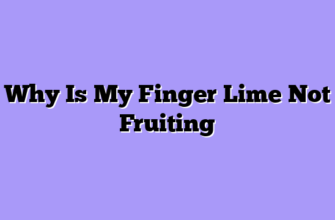Let me be brutally honest with you from the start: my first finger lime trees nearly died. I thought I knew citrus – I’d successfully grown lemons, oranges, and standard limes for ages – so how different could these Australian natives be? Turns out, very different. Citrus australasica, also called Australian finger lime, citrus caviar, or rainforest lime by locals down under, follows its own rules. These thorny little characters evolved in the subtropical rainforests of Australia’s east coast, and they haven’t forgotten their origins despite being cultivated worldwide now.
After killing two trees, nursing several back from near-death, and finally achieving consistent production, I’ve learned what actually works. Forget the generic citrus advice you’ll find rehashed everywhere. I’m going to share the real deal – the techniques that transformed my struggling finger lime grove into a productive operation that supplies restaurants and farmers’ markets with these premium fruits. If you’re ready to grow citrus caviar successfully, whether in your backyard or commercially, let’s dive into what actually matters.
Understanding What Finger Limes Actually Need
Here’s where most growers go wrong from day one: they treat Citrus australasica like regular citrus. Big mistake. While they’re technically in the Rutaceae family alongside oranges and lemons, these Australian natives behave more like their rainforest neighbors than typical citrus species. Think about where they come from – the understory of coastal rainforests where they grew beneath taller trees, protected from harsh afternoon sun and extreme temperature swings.

My breakthrough came when I stopped thinking “citrus” and started thinking “rainforest understory plant.” I moved my struggling trees from full blazing sun to locations with morning sun and afternoon shade. Within weeks, the transformation was remarkable. Leaves that had been yellowing and dropping suddenly darkened to a healthy green. New growth emerged. Those trees weren’t dying from disease – they were literally being cooked by too much direct sunlight in my climate.
Optimal Environmental Conditions:
| Factor | Requirement | Why It Matters | My Practical Approach |
|---|---|---|---|
| Light | 4-6 hours direct sun, partial shade | Mimics rainforest understory; prevents leaf burn | Morning sun with afternoon shade cloth or tree protection |
| Temperature | 50-90°F optimal (10-32°C) | Frost sensitive; struggles in extreme heat | Frost protection below 32°F; shade during heat waves above 95°F |
| Humidity | 40-60% ideal | Rainforest origins; dry air stresses plants | Mulch heavily; mist during dry spells in hot weather |
| Water | Consistent moisture, never waterlogged | Hates both drought and wet feet | Drip irrigation 2-3x weekly; well-draining soil essential |
| Soil pH | 5.5-6.5 (acidic) | Same as blueberries; alkaline soil causes chlorosis | Sulfur amendments if needed; annual testing |
Temperature management deserves special attention. These trees can tolerate brief dips to about 28°F, but anything colder will cause serious damage or death. I learned this the hard way during an unexpected cold snap that killed one of my early trees.
Now I have frost cloth ready to deploy whenever temperatures threaten to drop below freezing, and I keep small citrus-safe heaters available for extreme events. Some growers in marginal zones successfully grow Australian finger limes in large containers that can be moved to protected areas during winter – a smart strategy if you’re in USDA zones 8b or colder.
Planting and Establishment: Getting It Right From The Start
If I could go back and change one thing, it would be my planting technique. I initially dug holes, amended the soil, planted the trees, and walked away thinking I’d done everything right. Wrong. Finger limes need a much more thoughtful establishment process than standard citrus.
My Step-by-Step Planting Process That Actually Works:
- Site Selection First: Choose locations with natural afternoon shade or where you can easily provide it – think east-facing with buildings or larger trees blocking western sun
- Soil Preparation: Test pH first; if above 6.5, incorporate sulfur 2-3 months before planting to lower it gradually
- Drainage Testing: Dig your planting hole and fill with water – it should drain within 2-3 hours; if not, consider raised beds or mounds
- Proper Hole Dimensions: Dig 2-3 times wider than the root ball but no deeper – these trees hate being planted too deep
- Amendment Strategy: Mix 30% compost into removed soil, but avoid over-amending which can create a “bathtub effect”
- Root Preparation: Gently tease out circling roots from container-grown stock – this is crucial for establishment
- Planting Height: Position root ball crown slightly above ground level (1-2 inches) – it will settle
- Initial Watering: Create a watering basin and soak thoroughly immediately after planting
- Mulch Application: Apply 3-4 inches of organic mulch (wood chips work great) keeping it 4-6 inches away from trunk
- First-Year Protection: Install shade cloth or temporary protection structure for at least the first summer
The mulch point cannot be overstated. Citrus caviar trees absolutely thrive with heavy organic mulching. I use wood chips 3-4 inches deep in a circle extending to the drip line. This maintains soil moisture, moderates temperature, suppresses weeds, and slowly adds organic matter as it decomposes. Think of it as recreating the forest floor where these trees evolved.
Spacing matters more than you might think. I initially planted trees 8 feet apart, thinking that would be plenty. While it works, I now recommend 10-12 feet between trees for air circulation and ease of harvest. Those thorns I keep mentioning? They’re serious business. Having adequate space makes accessing fruit much less bloody.
Watering and Fertilization: The Goldilocks Zone
Here’s something that surprised me: finger limes are simultaneously more drought-sensitive and more susceptible to overwatering than regular citrus. How does that work? They want consistent moisture in well-draining soil that never stays soggy. It’s like they’re testing your horticultural skills constantly.
I struggled with this balance until I installed drip irrigation throughout my orchard. Hand-watering was inconsistent and labor-intensive, while drip lines deliver precise amounts on a predictable schedule. During active growth (spring through fall), my trees get deep watering 2-3 times weekly depending on temperature and rainfall. In winter, I cut back to once weekly or less.
The “deep watering” part is important. Shallow, frequent watering encourages shallow root systems that make trees vulnerable to stress. I run my drip lines for 45-60 minutes each session, allowing water to penetrate 12-18 inches deep. This encourages deep root development and creates more resilient trees.
Signs of Watering Problems I’ve Learned to Recognize:
- Underwatering: Leaves curling or cupping inward, fruit drop, overall wilting, yellowing from base upward
- Overwatering: Yellowing leaves (especially with green veins), constantly wet soil surface, root rot smell, fungal growth
- Perfect hydration: Deep green foliage, new growth at branch tips, healthy flowering, plump developing fruit
Fertilization requires a lighter touch than conventional citrus. These rainforest natives evolved in relatively rich but organically complex soils, not the heavy feeding regimen some citrus appreciate. I fertilize monthly during the growing season (March through October in my region) using a citrus-specific fertilizer at half the package-recommended strength. Yes, half strength. Over-fertilizing causes more problems than under-fertilizing with Australian finger limes.
My fertilizer of choice contains micronutrients, particularly iron, manganese, and zinc. Citrus australasica shows micronutrient deficiencies more readily than other citrus species, especially in slightly alkaline soils. I also supplement with foliar sprays of liquid kelp every 4-6 weeks, which seems to improve overall plant vigor and stress resistance.
Pruning, Pest Management, and Harvest Strategy
Let’s talk about those thorns everyone warns you about. They’re not exaggerating. Finger lime trees have numerous, sharp thorns distributed along branches and even on the trunk. Some varieties are thornless or reduced-thorn, but most cultivars bristle with them. This isn’t just an inconvenience – it fundamentally affects how you manage and harvest these trees.
Pruning becomes a delicate operation requiring thick leather gloves, long sleeves, and patience. I prune minimally in late winter (February-March), focusing on removing dead wood, crossing branches, and maintaining an open center for air circulation. Unlike heavy-pruning citrus strategies, finger limes respond better to light, thoughtful pruning. Over-pruning reduces fruit production significantly and can stress trees.
The open center shape serves multiple purposes: it improves air circulation (reducing fungal disease pressure), allows better light penetration for fruit ripening, and – critically – makes harvest somewhat less treacherous. I thin interior growth enough that I can reach in without getting shredded by thorns.
Pest and disease management in my orchard follows integrated pest management principles. The main culprits I deal with include:
Common Pests and My Management Approach:
- Asian Citrus Psyllid: This is the big one – it spreads citrus greening disease which is devastating. I monitor constantly and use selective insecticides when populations spike, along with beneficial insects like ladybugs
- Scale Insects: These sap-suckers love finger limes. Horticultural oil sprays during cooler months work well without harming beneficials
- Citrus Leafminer: Creates characteristic squiggly trails in leaves. Usually cosmetic; I only treat young trees where it impacts growth
- Spider Mites: Appear during hot, dry conditions. Strong water sprays and predatory mites usually keep them in check
Disease pressure stays relatively low if you maintain good cultural practices. Root rot from overwatering kills more finger lime trees than any disease organism. Proper drainage and watering protocols prevent most problems.
Harvest timing makes or breaks the final product quality. This is where experience becomes invaluable. Unripe fruit lacks the full flavor complexity and juicy pearls that make citrus caviar special. Overripe fruit develops off-flavors and the internal vesicles begin deteriorating.
My Harvest Timing Indicators Table:
| Indicator | Underripe | Perfect Ripeness | Overripe |
|---|---|---|---|
| Fruit Feel | Rock hard | Slight give when gently squeezed | Mushy, soft |
| Skin Color | Dull, lighter | Rich, vibrant color (variety dependent) | Beginning to dull |
| Stem Connection | Very firm | Releases with gentle twist | Falls off easily |
| Weight | Lighter | Heavy for size | Normal weight |
| Days from Fruit Set | 120-140 | 150-180 | 190+ |
I harvest by gently twisting ripe fruits. If they don’t release easily, they’re not ready. This requires multiple passes through the orchard rather than single large harvests – more labor-intensive but producing superior fruit. Wearing thick leather gloves is non-negotiable during harvest. Even with protection, I usually finish with a few scratches.
Post-harvest handling affects shelf life dramatically. Finger limes don’t have the long storage capability of standard citrus. I refrigerate harvested fruit immediately, where they’ll keep 2-3 weeks. At room temperature, they decline within a week. This limited shelf life affects marketing strategies – I focus on quick-turnaround sales to restaurants and weekly farmers’ markets rather than trying to hold inventory.
Variety Selection and Long-Term Success
Not all finger lime varieties perform equally in all locations. This took me a while to understand. I initially bought whatever varieties my local nursery stocked without researching performance characteristics. Some thrived; others struggled despite identical care.
The main commercial varieties include Collette, Judy’s Everbearing, Alstonville, Byron Sunrise, and Pink Ice, among others. Each has distinct characteristics regarding fruit color (ranging from pale yellow-green to deep purple-red internally), tree size, thorn density, and cold hardiness. Collette produces greenish-yellow fruit with pale pearls and shows good cold tolerance. Judy’s Everbearing, true to its name, produces multiple flushes throughout the year rather than one main crop.
After trying various cultivars, I’ve settled on a mix that spreads harvest across the season and provides color variety that appeals to chefs. My most productive trees are Collette for reliability and Crimson Tide for those stunning red pearls that command premium prices. But honestly? Success has more to do with matching varieties to your specific microclimate and providing proper care than finding some “magic” cultivar.
Investment and Return Reality Check:
Let me close with some honest economics. Finger lime trees require 3-4 years from planting to significant production. During that time, you’re investing in irrigation, fertilizer, pest management, and labor without much return. Patience is essential – these aren’t quick-profit trees.
However, mature trees producing well can generate impressive returns. My established trees yield 10-25 pounds annually, selling retail at $25-30 per pound. That’s $250-750 per tree annually – excellent returns compared to conventional fruit crops on a per-tree basis. The key is direct marketing to restaurants, specialty grocers, and upscale farmers’ markets where customers understand and pay for quality.
Growing citrus caviar successfully requires departing from conventional citrus wisdom. Embrace their rainforest origins, provide appropriate shade and consistent moisture, maintain acidic soil, protect from frost, and harvest patiently at peak ripeness. These trees reward proper care with remarkable fruits that command premium prices and create culinary excitement.
Is it worth the effort? Absolutely. But only if you’re willing to learn their specific requirements rather than applying generic citrus care. My struggling early trees taught me that lesson painfully. Now, watching my healthy orchard produce those incredible pearl-filled fruits for eager customers makes every early failure worthwhile. The best way to grow finger limes isn’t the easiest way – it’s the way that respects what these remarkable Australian natives actually need to thrive.








